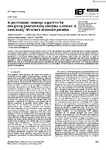Mostrar o rexistro simple do ítem
A point-based redesign algorithm for designing geometrically complex surfaces. A case study: Miralles's croissant paradox
| dc.contributor.author | Carballal, Adrián | |
| dc.contributor.author | Pazos Pérez, Rafael Iván | |
| dc.contributor.author | Rodríguez-Fernández, Nereida | |
| dc.contributor.author | Santos, Iria | |
| dc.contributor.author | García-Vidaurrázaga, María D. | |
| dc.contributor.author | Rabuñal, Juan R. | |
| dc.date.accessioned | 2024-01-12T10:09:30Z | |
| dc.date.available | 2024-01-12T10:09:30Z | |
| dc.date.issued | 2020 | |
| dc.identifier.citation | A. Carballal, R. Iván Pazos-Pérez, N. Rodriguez-Fernandez, I. Santos, M. D. García-Vidaurrázaga, y J. R. Rabuñal, «A point-based redesign algorithm for designing geometrically complex surfaces. A case study: Miralles’s croissant paradox», IET image process, vol. 14, n.o 12, pp. 2948-2956, oct. 2020, doi: 10.1049/iet-ipr.2020.0223. | es_ES |
| dc.identifier.issn | 1751-9659 | |
| dc.identifier.issn | 1751-9667 | |
| dc.identifier.uri | http://hdl.handle.net/2183/34867 | |
| dc.description.abstract | [Abstract]: This study explores the use of point clouds for both representation and genetic morphogenesis of complex geometry. The accurate representation of existing objects of complex curved geometry, which are subsequently geometrically modified by evolutionary morphogenetic processes, is analysed. To this end, as a method of representation and generation of complex geometries, a point-based genetic algorithm and the use of large unstructured point clouds are proposed. A study of convergence and diversity of the implemented algorithm is detailed, as well as a comparison with the Coyote optimisation algorithm in terms of representation error demonstrating its efficiency. Some commonly used three-dimensional formats in architecture, such as NURBS and polygon meshes, are analysed, and compared against point clouds. This study also includes an evaluation regarding whether the use of point clouds is a more suitable format for realistic representation, rationalisation and genetic morphogenesis. | es_ES |
| dc.language.iso | eng | es_ES |
| dc.publisher | Jonh Wiley & Sons | es_ES |
| dc.relation.uri | https://doi.org/10.1049/iet-ipr.2020.0223 | es_ES |
| dc.rights | Atribución 3.0 España | es_ES |
| dc.rights.uri | http://creativecommons.org/licenses/by/3.0/es/ | * |
| dc.subject | Geometry | es_ES |
| dc.subject | Genetic algorithms | es_ES |
| dc.subject | Splines (mathematics) | es_ES |
| dc.subject | Computational geometry | es_ES |
| dc.subject | Representation error | es_ES |
| dc.subject | Realistic representation | es_ES |
| dc.subject | Genetic morphogenesis | es_ES |
| dc.subject | Point-based redesign algorithm | es_ES |
| dc.subject | Geometrically complex surfaces | es_ES |
| dc.subject | Miralles's croissant paradox | es_ES |
| dc.subject | Complex geometry | es_ES |
| dc.subject | Complex curved geometry | es_ES |
| dc.subject | Evolutionary morphogenetic processes | es_ES |
| dc.subject | Point-based genetic algorithm | es_ES |
| dc.subject | Unstructured point clouds | es_ES |
| dc.subject | Implemented algorithm | es_ES |
| dc.subject | Coyote optimisation algorithm | es_ES |
| dc.title | A point-based redesign algorithm for designing geometrically complex surfaces. A case study: Miralles's croissant paradox | es_ES |
| dc.type | info:eu-repo/semantics/article | es_ES |
| dc.rights.access | info:eu-repo/semantics/openAccess | es_ES |
| UDC.journalTitle | IET Image Processing | es_ES |
| UDC.volume | 14 | es_ES |
| UDC.issue | 12 | es_ES |
| UDC.startPage | 2948 | es_ES |
| UDC.endPage | 2956 | es_ES |
Ficheiros no ítem
Este ítem aparece na(s) seguinte(s) colección(s)
-
GI-RNASA - Artigos [193]






